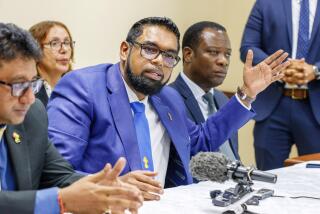Guyana Has Gold, Diamonds and Poverty : Despite Rich Natural Resources, Country’s Economy Is in Shambles
- Share via
GEORGETOWN, Guyana — Although it has bountiful resources, including gold and diamonds, Guyana is in the throes of one of the worst economic declines in the developing world.
Its 750,000 people face chronic shortages of electricity, water, transportation, fuel and food. Jobs are scarce, and prices are soaring. A gallon of milk costs the equivalent of $3, three times the average daily wage.
Its only thriving economic sector is the black market.
Frustration is giving way to violence and strikes.
Fearing riots similar to those that killed 176 people in neighboring Venezuela in late February and early March, Guyana’s military is on alert. The unrest here is simmering at its worst since race riots left hundreds dead in the mid-1960s.
The World Bank estimates Guyana, a former British colony on South America’s northeast shoulder and the continent’s only English-speaking nation, has had the worst economic decline in the Third World over the last decade.
“We have sunk almost to the bottom of the table, perhaps just above Haiti and Bolivia,” the Stabroek News, an independent daily, commented recently.
Guyana has had virtually no economic growth in 10 years and in the mid-1980s suspended payments on its foreign debt, now $1.9 billion. Western creditors have stopped most aid to the country.
But not only does Guyana, which is about the size of Idaho, have a big foreign debt for its size, it has no foreign exchange reserves. It has borrowed $1 billion just to keep foreign currencies on hand for emergencies.
Last year, when the government needed more local currency--the Guyanese dollar--it simply printed it.
Without hard currencies such as the U.S. dollar, Guyana cannot afford to import parts or buy technology, and this has left its infrastructure--roads, bridges, sewers, electric and water treatment plants--to deteriorate. An exodus of skilled workers and poor production of its three major exports--sugar, bauxite and rice--also contribute to the slump.
But the crisis also points to the government’s establishment in 1980 of a cooperative republic “in transition from capitalism to socialism.”
In the last two years, President Desmond Hoyte has backed away from much of the socialism of his predecessor, Forbes Burnham, who led Guyana to independence from Britain in 1966.
Burnham died in 1985 after years of authoritarian rule. During his presidency, he nationalized 80% of the economy and discouraged foreign and private investment in a bid to make Guyana a self-sufficient, nonaligned socialist republic.
Critics also blame the crisis on mismanagement, resistance to democratic reform and alleged corruption by Burnham’s People’s National Congress, which has dominated politics since he became president in 1966. The elections in December, 1985, which brought Hoyte to office, were widely regarded as fraudulent.
“There is a big question over elections which has never been addressed, and it’s a cancer in the life of the country,” Anglican Bishop Randolph George said. “The style has changed with Burnham’s death, but it’s the same old gang. It’s a mini-dictatorship.”
Although the government maintains Burnham’s socialist policies were not responsible for Guyana’s decline, a pending agreement with the International Monetary Fund signals a change of course.
“Private enterprise doesn’t conflict with socialism,” Prime Minister Hamilton Green said. “We need large inputs of money, and we hope the IMF program will provide incentives needed to grow.
“But it’s going to be rough, very rough,” he said.
Western creditors want an International Monetary Fund agreement before giving Guyana new aid. So on March 31, Hoyte imposed a three-year International Monetary Fund program that devalued Guyana’s currency by 70%, doubled interest rates to 35% and triggered 300% price hikes.
To soften the blow, the government gave state workers a 20% pay increase. But that is small change for salaries that dropped in value to $1 a day from $2.50 as a result of the devaluation. Food prices skyrocketed. Workers have to work two days to buy a pound of chicken or a pint of cooking oil.
“A 20% increase is not enough. We need 1,000%,” said Lincoln Lewis, president of the Guyana Mine Workers Union, representing 4,000 of the 5,000 workers in the bauxite industry.
About 20,000 workers from the state-owned sugar industry and all workers in the bauxite sector responded to the International Monetary Fund program by walking off their jobs. A sympathy teachers’ strike shut down the University of Guyana. In the monthlong walkouts, about 140 people were arrested, most in demonstrations.
Guyanese Urged to ‘Agitate’
“We are going down, like the rest of Latin America, with policies imposed by North America,” said Cheddi Jagan, a former prime minister and minority leader in the Parliament who has called on Guyanese to “agitate” against government policy.
Guyana has two main ethnic groups--blacks of African descent and East Indians. Political parties are based largely on racial lines.
Jagan represents the Indians, who make up about 50% of the population. Hoyte draws his support mainly from urban blacks, about 30% of the population.
But the current unrest is economically based.
Protesters have hurled Molotov cocktails at government buildings, and arsonists have destroyed about $800,000 worth of sugar cane. Dunstan Barrow, chief executive for the bauxite sector, said the strike has cost the industry $1.5 million.
Combined earnings from the bauxite and sugar industry are about $200 million a year but a drought in 1988 hurt sugar output. Last year, Guyana had to import sugar because it produced barely enough to meet its obligation to the European Economic Community. Production was 170,000 tons, slightly less than half of its projections.
Evidence of neglect abounds.
Because of poor drainage, heavy rains often flood the littered and potholed streets of Georgetown, a once-gleaming capital settled by the Dutch in the 16th Century that boasted broad avenues, wooden colonial buildings and houses at the mouth of the Demerara River.
Scheduled Blackouts
Daily routines such as cooking, cleaning or taking baths are timed around scheduled blackouts that average seven hours a day but often last 20 hours. The outages, which sometimes are unscheduled, knock out water and fuel pumps, creating shortages.
Forests take up about 80% of Guyana’s 85,000 square miles. Most of the population lives along the 235-mile Atlantic coastline, the region most in need of energy. One of Georgetown’s three aging generators has shut down. The other two limp along with repairs. Of the 45 megawatts needed at peak times, only 13 megawatts are going out.
Homemakers line up for hours outside thinly stocked grocery stores. Others turn to “suitcase traders”--people who sell goods picked up in neighboring Suriname, Venezuela or Brazil, usually with contraband gold sold for U.S. dollars.
In 1987, Guyana produced 22,400 ounces of gold, but an estimated 100,000 ounces are believed smuggled out each year, about $40-million worth.
By law, gold must be sold to the Guyana Gold Board, which pays at lower prices in the devalued Guyana currency rather than U.S. dollars.
Other important exports are diamonds, shrimp and timber, which the United States imports. But production declines brought on by shortages of parts and fuel have hurt those areas too.
Black Market
Economic activity thrives in Georgetown’s “Wall Street,” as the black market is called. Young men with gold chains around their necks and wads of Guyanese currency in their hands trade in coveted U.S. dollars.
With devaluation, the official exchange is 33 Guyanese dollars to one U.S. dollar. On the black market, it is more like 50 to 1.
“I’ve been doing it for seven years,” one young dealer said. “I don’t know what I would do if it stopped.”
Guyana’s poor quality of life is causing skilled workers--teachers, doctors, nurses, managers--to flee. Despite an increase in the birth rate, the population has dropped in the last decade by about 100,000. U.S. officials estimate that 5% of the population awaits immigration visas.
Lines outside the U.S. Embassy form at dawn.
Leslie Mellville, spokesman for the Independent Federation of Trade Unions, representing 50,000 of the 80,000 unionized workers, said workers have lost faith in the country.
“The future isn’t promising, and people aren’t motivated to work. So the main alternative is to leave the country,” he said.
GUYANA AT A GLANCE GEORGETOWN, Guyana --Here are some facts and figures on Guyana.
History: The Guianas, a region that today includes Suriname, French Guiana, Guyana and parts of Brazil and Venezuela, was sighted by Columbus in 1498. But Guyana was not settled until late in the 16th Century, when the Dutch arrived. The British became the rulers in 1796 and established British Guiana in 1831. Independence was granted in 1966. Guyana, which means “Land of Many Rivers,” became a republic in 1970 and was declared a cooperative republic “in transition from capitalism to socialism” by the 1980 constitution. Forbes Burnham became president in 1966 and ruled until his death in 1985.
The People: Most of the population of 780,000 is made up of English- and Creolese-speaking people. The literacy rate is about 90%. Most of the people are descendants of African slaves or indentured servants, mostly from India and a few from Portugal. Slavery was abolished in 1833.
The Land: Guyana is a tropical country on the northeastern coast of South America between Suriname and Venezuela. Its 83,000-square-mile area is about the size of Idaho. About 80% of the land is rain forest and savanna, laced by rivers and rich in rice lands, wildlife, gold, diamonds, semi-precious stones and timber. The most populated region is along the 235-mile Atlantic coastline.
Politics: Politics are based more on ethnic lines than on ideology, with the governing People’s National Congress supported by urban blacks and the People’s Progressive Party of Cheddi Jagan by Indo-Guyanese, who are about 49% of the population. The National Congress, first under the late President Forbes Burnham, and now under President Desmond Hoyte, has governed since 1964. Opposition parties, Western governments and human rights organizations charge the National Congress maintains power by election fraud. National elections were held in 1985. The next elections must be held no later than this December, although Hoyte could call them earlier.
The Government: Guyana has a modified parliamentary system, with legislative power in a unicameral National Assembly. The president, who is the leader of the majority party, is the chief executive and appoints a prime minister and a Cabinet. The prime minister is the vice president.
The Economy: The government has launched a major drive for foreign investment to spur the economy, which is nearly stagnant and dominated by a black market created by the country’s depleted foreign exchange account. Economists estimate black market transactions account for 80% of the country’s economic life. The country has a foreign debt of $1.9 billion. Official estimates of unemployment and inflation are not available.
Source: Associated Press
More to Read
Sign up for Essential California
The most important California stories and recommendations in your inbox every morning.
You may occasionally receive promotional content from the Los Angeles Times.









